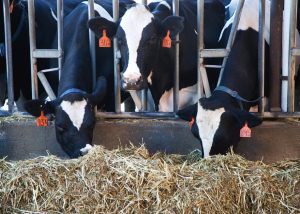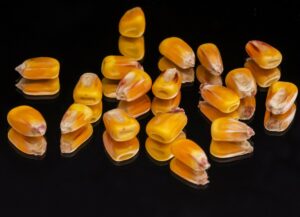Álvaro García
Dairy cows exhibit significant daily variations in body weight due to factors such as feed intake, hydration levels, and waste excretion. These fluctuations can make direct weight measurements unreliable for assessing a cow’s nutritional status. Consequently, body condition scoring (BCS) has become a preferred method for evaluating energy reserves. This technique involves visually and manually assessing fat cover over specific anatomical points, providing insights into the cow’s long-term nutritional health.
The National Academies of Sciences, Engineering, and Medicine (NASEM) released the eighth revised edition of the “Nutrient Requirements of Dairy Cattle” in 2021, updating guidelines to reflect advancements in dairy nutrition science. This edition emphasizes the importance of monitoring and managing body condition to optimize health and productivity. The updated recommendations provide detailed nutrient requirements tailored to various stages of lactation and production levels, underscoring the role of proper nutrition in maintaining optimal body condition.
High feed costs can sometimes lead to decisions that compromise the nutritional quality of diets offered to cows at different physiological stages. While prioritizing high-quality feeds for lactating cows to maximize milk production is common, it’s crucial not to neglect the nutritional needs of dry cows. Providing low-quality forages to dry cows, particularly during the early dry period, can adversely affect their return to reproductive activity post-calving and increase the incidence of metabolic disorders. Regular BCS evaluations can aid in assessing nutritional status across different groups within the herd, allowing for more strategic feed allocation that supports overall health, fertility, and economic returns.
Body condition and postpartum reproductive recovery
In early lactation, the energy demands for milk production typically outpace the cow’s ability to consume sufficient nutrients, particularly during the first four to six weeks after calving. This mismatch results in a state of negative energy balance, during which the cow mobilizes stored fat and muscle tissue to support milk synthesis. The degree to which body condition score (BCS) declines in the first 60 days postpartum reflects the cow’s genetic capacity for production, her prepartum nutritional status, and the adequacy of her transition diet.
According to the 2021 Nutrient Requirements of Dairy Cattle (NASEM), achieving a timely shift from negative to positive energy balance—often around 6 to 8 weeks post-calving—is critical for restoring metabolic function and initiating reproductive cycling. Cows that remain in a prolonged catabolic state are more likely to experience delayed ovulation, suboptimal follicular development, and reduced conception rates. In contrast, cows that maintain a moderate BCS (typically 3.0 to 3.5 on a 5-point scale) around calving tend to resume normal estrous activity sooner, contributing to shorter calving intervals and improved reproductive efficiency.
Longitudinal studies have demonstrated that BCS at calving is positively associated with the cumulative percentage of cows returning to estrus within the first 80 days postpartum. Cows in poor body condition are more likely to experience anovulatory cycles and weaker reproductive hormone responses. Additionally, cows with insufficient BCS postpartum have been shown to produce fewer morphologically normal oocytes, while those within the moderate BCS range exhibit greater follicle numbers and higher-quality ova. A study by Roche et al. (2009) found that cows with a moderate BCS at calving exhibited earlier resumption of ovarian cyclicity and improved follicular health compared to cows with either low or high BCS. These findings align with modern reproductive physiology, emphasizing the importance of balanced energy reserves in promoting ovulatory function and optimizing first-service conception rates.
The ability to resume ovarian activity early has practical implications for reproductive management. It allows producers to minimize the voluntary waiting period, optimize first-service conception rates, and avoid extended days open—all of which directly impact farm profitability.
By 60 days in milk, cows should ideally reach a body condition score between 2.75 and 3.00. This range reflects the recovery from peak negative energy balance and supports the resumption of normal reproductive activity. Cows that fail to regain sufficient condition by this point may experience continued reproductive delays or metabolic challenges, making early nutritional intervention critical.
Body condition and health implications
Maintaining cows within the optimal body condition score (BCS) range is critical to promoting health, reproductive success, and overall performance. Both low and excessively high BCS values are associated with a higher risk of metabolic and immune-related disorders, particularly during the transition period—the three weeks before and after calving—when physiological demands are at their peak.
Cows entering this period with a BCS above 3.75 are more likely to experience excessive fat mobilization due to reduced dry matter intake around calving. The resulting increase in circulating non-esterified fatty acids (NEFAs) can exceed the liver’s metabolic capacity, leading to the accumulation of triglycerides—a condition known as fatty liver syndrome. This condition compromises liver function and has been linked to higher rates of clinical ketosis, displaced abomasum, mastitis, and metritis, all of which impact both cow welfare and economic performance.
On the other hand, cows with a BCS below 3.25 at dry-off may lack adequate energy reserves to support the demands of early lactation. These animals are at increased risk for prolonged negative energy balance, delayed return to estrus, and reduced immune function. However, cows in this category can benefit from higher-energy prepartum diets, if they remain in a state of positive energy balance to minimize the risk of hepatic fat deposition (NASEM, 2021).
Importantly, feed restriction is not an effective or safe method to reduce BCS in over-conditioned cows, as it promotes further fat mobilization and worsens the risk of fatty liver. Studies show that up to 50% of cows in commercial herds develop some degree of liver fat infiltration during early lactation (Bobe et al., 2004). These metabolic imbalances are costly. Recent estimates continue to highlight the significant economic burden that clinical ketosis imposes on the dairy industry. While older figures estimated annual losses in the United States at around $60 million (Kelton et al., 1998), more current assessments suggest even broader global impacts. A 2024 report identified clinical ketosis as contributing to approximately $200 million in annual global losses, factoring in treatment, reduced milk yield, impaired fertility, and increased risk of other disorders. The per-case economic burden remains highly variable, with a systematic review reporting costs ranging from €19 to €812, depending on the production system, treatment protocols, and severity of the case. In the U.S., more recent estimates place the average cost per case at approximately $117, with slightly higher losses observed in first-lactation cows ($134) compared to older cows ($111). These updated figures reinforce the critical need for proactive BCS management and nutritional strategies to reduce the incidence of metabolic disorders like ketosis and protect both cow health and farm profitability.
Beyond metabolic disorders, improper BCS management can lead to lameness, poor udder health, and shortened productive life spans. By achieving and maintaining a BCS between 3.25 and 3.5 at both dry-off and calving, producers can reduce transition cow problems, improve milk yield, and support reproductive efficiency across the lactation cycle.
A simple model using herd averages shows that maintaining cows at an optimal BCS throughout the transition period can prevent losses of $100–150 per cow per year. In a 500-cow herd, this equates to potential savings of $50,000–$75,000 annually by reducing metabolic disorders, improving reproduction, and lowering culling rates. The initial investment in automated BCS monitoring tools can often pay for itself within 12 to 18 months through improved herd performance.
Feeding strategies to support optimal body condition
With feed costs representing a major portion of dairy production expenses, maximizing feed efficiency is a top priority. However, it’s important to recognize that high feed efficiency values observed in early lactation are often misleading. These early gains typically result not from improved dietary utilization, but from the cow’s reliance on mobilized body fat to meet the energy demands of peak milk production.
During the first several weeks postpartum, dry matter intake (DMI) lags energy output, and body reserves are used to fill the gap. This results in temporarily inflated feed efficiency values—often cited around 2.4 pounds of milk per pound of DMI. As intake begins to rise around week six to eight, feed efficiency declines naturally, and cows begin to recover body condition. Beyond this point, if feed management does not account for energy balance and BCS recovery, cows may struggle with health issues or fail to meet reproductive benchmarks.
Maintaining an ideal BCS throughout the lactation and especially by the end of lactation is key to setting cows up for a successful transition period. Cows should ideally finish lactation with a BCS of 3.25 to 3.5, so that they enter the dry period without needing significant weight gain. To achieve this goal, cows should gradually regain condition during mid-lactation, aiming for a BCS of 3.00 to 3.25 by approximately 100 days before dry-off. This proactive strategy prevents the need for rapid fat deposition in late lactation, which can predispose cows to over-conditioning and increase the risk of metabolic disorders in the transition period. Gaining body condition during the dry period—especially in the final weeks before calving—can predispose cows to fatty liver and related metabolic disorders. Conversely, cows that are under-conditioned at dry-off are more likely to mobilize excess fat postpartum, increasing the risk of ketosis.
Consistency in DMI is another crucial aspect of managing BCS. Studies have shown that even a small (1%) increase in variability of dry matter intake can raise the likelihood of transition disorders by up to 4% (McGuffey et al., 1997). Feeding strategies should aim not only for nutrient balance but also for stable and predictable intake patterns.
Social dynamics also influence BCS, particularly when primiparous and multiparous cows are grouped together. Competition for resources such as bunk space and lying areas can lead to uneven intake and condition loss in subordinate animals. To mitigate this, ensure that stocking density allows for adequate access to feed, water, and comfortable resting areas for all animals.
Forages used in dry cow diets are often lower in energy density and digestibility, but not all low-quality forages are acceptable. Contaminated or moldy feeds—often distinguishable by off odors—can lead to reduced intake or feed sorting, disrupting BCS maintenance. Cows already in suboptimal condition are especially vulnerable to these inconsistencies and may lose further condition heading into calving.
Prepartum diets should gradually increase energy density, typically by incorporating small amounts of grain or energy-dense ingredients, to support the metabolic demands of calving and early lactation. Even with well-managed transitions, some degree of body condition loss is expected postpartum, but minimizing its extent is crucial for fertility, milk yield, and long-term productivity. Ultimately, the goal is not just to feed efficiently, but to feed strategically—matching diet formulation with stage of lactation, cow condition, and transition readiness.
While this article focuses primarily on confinement-based systems common in North America and Europe, BCS management is equally critical in grazing and robotic milking systems. In pasture-based operations, seasonal forage quality and longer walking distances often lead to greater BCS fluctuations, requiring specific nutritional strategies. Similarly, in robotic milking herds, frequent milking can intensify early lactation demands, highlighting the need for more frequent condition monitoring.
A modern approach to body condition assessment
A new generation of 3D camera systems is revolutionizing how dairy producers assess cow health and productivity. Among these, the Dellait Biometric Monitoring System stands out for its combination of advanced imaging, rigorous methodology, and Swiss-engineered precision. Designed for non-invasive use, the system captures a rapid series of depth images as cows move naturally through the barn, requiring no restraint or physical contact.
By analyzing hundreds of key surface points on each animal, the system builds a comprehensive “point cloud”—a three-dimensional map composed of thousands of spatial coordinates. These data points represent anatomical landmarks such as hooks, pins, spine, and ribcage. From this digital model, the software accurately evaluates body condition score (BCS), focusing on curvature, angularity, and tissue cover in specific regions.
In addition to condition scoring, the system also estimates body weight by combining point cloud data with validated algorithms and calibration benchmarks. Unlike traditional weighing methods that can be skewed by gut fill or udder volume, 3D imaging offers consistent, objective measurements that improve tracking over time. The same technology also supports early detection of lameness by identifying subtle changes in gait and posture, enabling timely intervention. Together, these capabilities provide dairy managers with a reliable, data-driven tool for proactive herd health and performance management.
Several other commercial systems, including those by DeLaval, Lely, and SCR, also offer automated body condition scoring. While most rely on image capture from fixed overhead or angled cameras, the Dellait Biometric Monitoring System distinguishes itself using high-resolution depth imaging combined with anatomical mapping. Its capacity for real-time data integration and multi-trait evaluation (including lameness detection) makes it a comprehensive tool rather than a single-parameter monitor.
Effective management of body condition is essential for optimizing dairy cow health, fertility, and productivity across all stages of lactation. BCS serves as a critical tool to monitor energy balance and nutritional adequacy, helping producers make informed feeding and management decisions. Whether addressing the risks of over-conditioning, mitigating the challenges of negative energy balance postpartum, or ensuring reproductive success, maintaining cows within the optimal BCS range (3.25 to 3.5) is central to herd profitability and animal welfare. The integration of advanced technologies, such as 3D camera systems, enhances the precision and consistency of condition scoring by eliminating subjective variability and enabling real-time, non-invasive monitoring. These systems offer a modern, scalable solution to track body condition, estimate weight, and detect early signs of lameness—empowering producers to take proactive steps that support long-term sustainability in dairy operations.
Implementing BCS management is not solely a technical task, it requires training, consistency, and a culture of accountability. Variability in manual scoring between farm workers can lead to inconsistent decisions. Likewise, adoption of new technologies often depends on labor willingness, understanding of benefits, and user-friendly design. Ensuring proper onboarding and regular calibration of automated systems helps maximize their effectiveness and maintain team engagement.
References:
Elanco Animal Health, 1997. Body Condition Scoring in Dairy Cattle. Indianapolis, IN.
Hanson, M. (2024, August 7). The cost of the world’s top-12 dairy diseases. Dairy Herd Management.
Krogh, M. A., et al. (2020). Systematic review: Economic impact of production diseases in dairy cattle. Journal of Dairy Science, 103(10), 9615–9633.
Leach, T. (2021, December 14). 7 transition period diseases that cost your clients the most. Bovine Veterinarian.
Kelton, D.F., K.D. Lissemore, and R.E. Martin. 1998. Recommendations for recording and calculating the incidence of selected clinical diseases of dairy cattle. J. Dairy Sci. 81:2502-2509.
McGuffey, R. , J. Symanowskil, J. Kubel, J. Shirleyz, R. Wallace, and J. Clark. 1997. Variation in feed intake as a predictor for the subsequent occurrence of health conditions in the postpartum transition cow. Journal of Dairy Science Vol 80, Suppl. 1.
National Academies of Sciences, Engineering, and Medicine. (2021). Nutrient Requirements of Dairy Cattle: Eighth Revised Edition. Washington, DC: The National Academies Press.
Roche, J. R., Friggens, N. C., Kay, J. K., Fisher, M. W., Stafford, K. J., & Berry, D. P. (2009).
Body condition score and its association with dairy cow productivity, health, and welfare. Journal of Dairy Science, 92(12), 5769–5801.
Wildman, E. E., G. M. Jones, P. E. Wagner, R. L. Boman, H. F. Troutt,Jr., and T. N. Lesch. 1982. A dairy cow body condition scoring system and its relationship to selected production characteristics. J. Dairy Sci. 65:495–501.
© 2025 Dellait Knowledge Center. All Rights Reserved.









